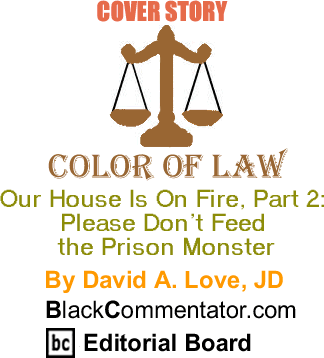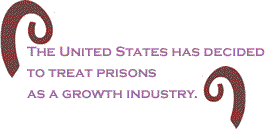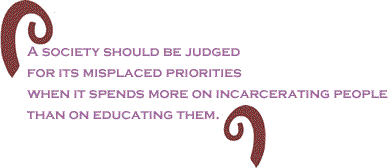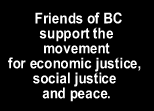
|
|||||||||||||||||||||||

Custom Search
|
|
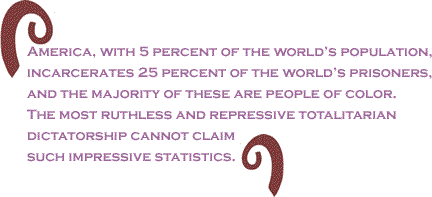 |
|
Click here to read any of the commentaries in this series. At its worst, America’s criminal justice system represents the place where racism, greed and corruption intersect. At its best, it is inherently flawed, unjust, and unreliable, and little better than its worst. The engine that drives this injustice system is known as the prison industrial complex. It is the theater in which the nation’s foremost method of social control—and a failed method at that—plays itself out to the detriment of society. Recent events help to underscore just how bad things are:
By itself, any one of these stories shocks the conscience. We would hope that these sordid tales are the exception to the rule. However, these cases reflect a dysfunctional system that is functioning as designed by a dysfunctional society. Allow me to demystify the prison industrial complex and identify the threads that connect the crooked judges in Pennsylvania and Texas, and overcrowded prisons in California.
It was no accident that the United States became the nation with the world’s largest prison population, with 2.3 million behind bars, and a total of 7.3 million in jail, prison, parole or probation, or 1 in every 31 adults. America, with 5 percent of the world’s population, incarcerates 25 percent of the world’s prisoners, and the majority of these are people of color. The most ruthless and repressive totalitarian dictatorship cannot claim such impressive statistics. Public policy, informed by a legacy of Jim Crow racism, the profit motive and obscene, misplaced priorities, explains it all.
Every factory requires raw materials. The raw materials for the prison-as-factory are Blacks and Latinos, and poor Whites—uneducated, in many cases illiterate, and unskilled casualties of a system that has programmed their failure through a cradle-to-prison pipeline. The criminalization of youth of color, systemic poverty, failed public schools and the wholesale denial of opportunity is fundamental to this pipeline. In order to ensure a steady stream of Black, Brown and poor White bodies, these raw materials, into the factory, you must maintain the right policies. So, in the Jim Crow segregated South, the powers that be decided to keep Blacks in their place and eviscerate their political power, to maintain a system of slavery after slavery had been supposedly abolished. Through the Black Codes, the Southern establishment criminalized certain behaviors that were associated with the Black community. Certain offenses such as “mischief,” “insulting gestures” “cruel treatment to animals,” and the “vending of spiritous or intoxicating liquors” applied only to African Americans. In addition, it was illegal for Blacks to cohabit with Whites (which carried a life sentence) or keep firearms. Kangaroo courts were utilized to fill the prisons with Black men, who were farmed out for their labor and summarily, forever, denied the right to vote.
Nowadays, a high-tech Jim Crow has met the information age. In recent decades, the war on drugs has resulted in draconian sentencing, particularly for crack cocaine (a drug associated with poor drug users of color) vs. powdered cocaine. Politicians climb the career ladder through their tough on crime stance, exploiting White fears of Black criminality. Police conduct raids and sweeps in Black and Brown poor communities, rather than the suburbs and posh corporate suites, to find illegal drug activity. Communities of color are punished in the process. Black and Latino men (and increasingly women) are shipped upstate to far-flung prisons in White communities. Their families can visit them only through great personal and financial hardship. In a new twist on the infamous Three-Fifths Compromise (which counted slaves as three-fifths of a person for the benefit of the Southern states in terms of Congressional apportionment and the distribution of taxes), these prisoners are counted as residents of these rural for census and tax purposes. Yet, they are unable to vote, and in many cases unable to vote after they complete their sentence (about 5.3 million people cannot vote because they have felony convictions, including 13% of all Black men). Meanwhile, the mostly urban communities that raised them are depleted of resources— human, political and economic. And the lynching of Black men was made cleaner, legitimate and more “respectable” by bringing it into the justice system in the form of state-sponsored executions. Executions, like Texas backwater lynchings, are arbitrary, barbaric and race-based. The defendant typically is a man of color, the underlying crime involves a White victim (80% of the time, according to the Death Penalty Information Center), and the chief prosecutor is White (98% of the time). Like the lynch mob, the administrators of the death penalty system ultimately care little about guilt or innocence. Someone’s got to pay, and anyone will do. When soon-to-be former Judge Keller expressed her sentiments that we can’t give every innocent person a new trial, she was getting at the heart of a criminal justice system that cares everything about finality and little about true justice. And so, new raw materials are constantly required to satisfy the hunger of the prison machine.
Those who are interested in the expansion of the prison boom, including the corrections officers’ union in California, private prison firms, and others, lobby state legislatures for longer, harsher sentences to keep more people behind bars for longer periods of time. As a result, ruinous policies based on catchy slogans, including three strikes laws, have prevailed. And as the prison population has burgeoned in the process, so too have the state budget allocations for prison spending. A society should be judged for its misplaced priorities when it spends more on incarcerating people than on educating them. But this is where criminal justice policy clashes with economic reality. At a time when states are going bankrupt—unable to pay their state employees, unable to pay tax refunds, or unable to collect the trash—ineffective profligate prison spending is breaking the banks of state governments. And despite the promises of a retributive and punitive legal regime, the war on drugs has been an abysmal failure. Draconian sentencing destroys communities and does not fight crime. America’s attitude towards drugs and drug policy, not to mention a steady supply of guns from the U.S., is wreaking havoc on cartel-ridden Mexico. And as the Obama administration has signaled that the federal government is moving away from the decriminalization of marijuana, California is now considering legalizing marijuana and taxing it to bring in billions of dollars in annual revenue. One thing is for sure: the current path is bankrupting the United States, both in a moral and economic sense. The prison building madness has run its course, and it is time for it to stop. In a nation that has tried to make a buck from just about everything, including human bondage and the misery of others, America must stop feeding the prison monster. Click here to read any of the commentaries in this series. BlackCommentator.com Editorial Board member David A. Love, JD is a lawyer and journalist based in Philadelphia, and a contributor to the Progressive Media Project, McClatchy-Tribune News Service, In These Times and Philadelphia Independent Media Center. He contributed to the book, States of Confinement: Policing, Detention, and Prisons (St. Martin's Press, 2000). Love is a former Amnesty International UK spokesperson, organized the first national police brutality conference as a staff member with the Center for Constitutional Rights, and served as a law clerk to two Black federal judges. His blog is davidalove.com. Click here to contact Mr. Love. |
|
Any BlackCommentator.com article may be re-printed so long as it is re-printed in its entirety and full credit given to the author and www.BlackCommentator.com. If the re-print is on the Internet we additionally request a link back to the original piece on our Website. Your comments are always welcome. eMail re-print notice
If you send us an eMail message we may publish all or part of it, unless you tell us it is not for publication. You may also request that we withhold your name. Thank you very much for your readership. |
|
| |
|
| March
19 , 2009 Issue 316 |
|
| Executive Editor: Bill Fletcher, Jr. |
| Managing Editor: Nancy Littlefield |
| Publisher: Peter Gamble |
| Est. April 5, 2002 |
Printer Friendly Version
in resizeable plain
text format or pdf
format. |
| Frequently Asked Questions |
 |
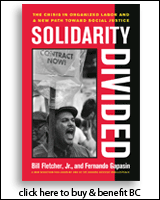
|
 |
 |
 |
| |
| |




























